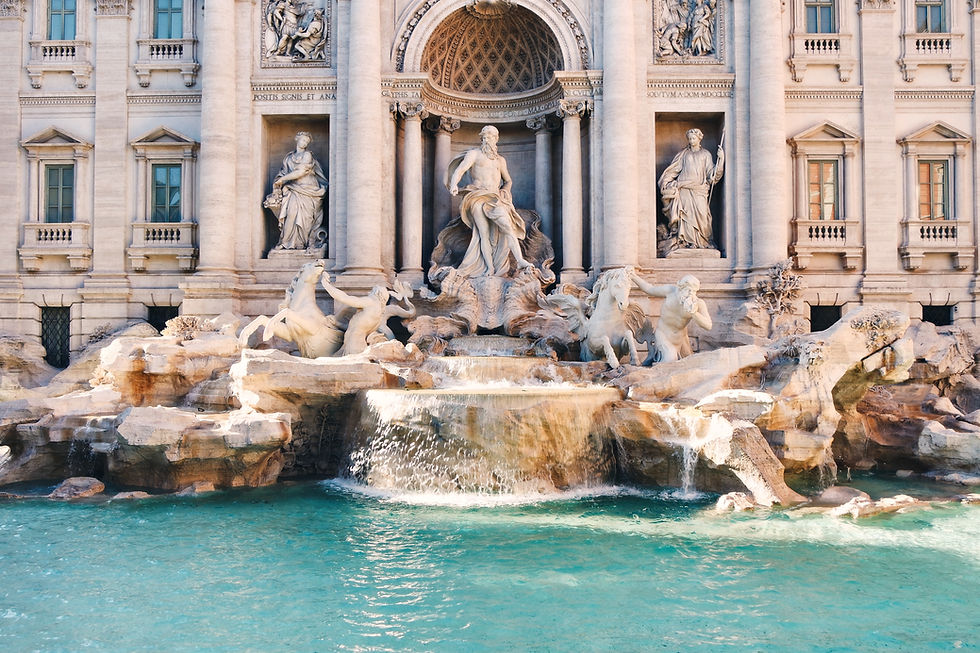ROME
Piazza di Spagna
The Piazza di Spagna is one of the most popular and busiest squares in Rome. The famous Spanish Steps with their 135 travertine steps are the work of Francesco de Sanctis. While the lower end of the Spanish Steps is adorned with the "Fontana La Barcaccia" fountain, it ends at the top with the French church "SS. Trinità dei Monti". Also impressive is the huge Egyptian obelisk that rises into the sky between the stairs and the church.
The area around the Piazza di Spagna, the Piazza del Popolo and the Villa Borghese is very extensive and you need a lot of time to see the most important sights, to enjoy the special atmosphere and to walk in the very large Villa Borghese.

Piazza Navona & Pantheon
The Piazza Navona is framed by beautiful churches, houses and palaces: the Palazzo Braschi (Museo di Roma), the Church of Sant'Agnese and the Palazzo Pamphili. In the center of Piazza Navona is the monumental fountain Fontana dei Quattro Fiumi, built by Bernini in the 16th century. The 4 giants of the fountain represent the four largest known rivers on earth at that time - Ganges, Danube, Nile and Rio de la Plata.
Pantheon - In the Middle Ages, this Roman temple dedicated to the gods became a church. The Pantheon, with its diameter and height of 43 meters and its huge dome, is a symbol of Rome and a marvel of Roman architecture. In the Piazza del Pantheon (Piazza della Rotonda) we find the Fontana della Rotonda fountain.

Fontana di Trevi
The Trevi Fountain is located near the Piazza di Spagna and is one of the main attractions of Rome, everyone wants to have their picture taken there and toss a coin in the fountain to make sure they will come back to Rome one day. The fountain is modeled on a large stage. Part of the Fontana di Trevi is integrated into the facade of the Palazzo Poli and has the shape of a triumphal arch.

Vaticano
The Vatican is a city-state, the seat of the Pope and the center of the Roman Catholic Church. This place attracts believers from all over the world and contains countless famous works of art and buildings. More than 20,000 people visit St. Peter's Basilica every day, for which the foundation stone was laid in 1506 and which took around 120 years to build. The spectacular 136 meter high dome that gives the basilica its majestic dominance was designed by Michelangelo. The view from the dome of St. Peter's Square, the Tevere River and the city is fantastically beautiful.
Vatican Museums and Cappella Sistina- The buildings, which now house one of the most valuable art collections in the world, were built as a palace for the Renaissance popes. The museum complex includes the Sistine Chapel and Raphael's Rooms and Loggias.

Trastevere
Trastevere - The pedestrian bridge Ponte Sisto, connects the center of Rome with the Trastevere district. It is a lively district and has many beautiful streets, houses and churches. From the Trastevere district, if you climb the hill, you get to the Gianicolo Park.

Colosseum & Fori Imperiali
The Colosseum is the most famous building of the Roman Empire. The place of entertainment was 80 AD. opened with a hundred-day festival and offered space for 50,000 people. Right next to the Colosseum is the mighty triumphal arch that documents Constantine's victory over Maxentius.
From here you can walk to the Roman Forum, along the Fori Imperiali and see the remains of ancient Rome. The Roman Forum was the center of political, economic and judicial life in ancient Rome


ENJOY ROME THE ETERNAL CITY